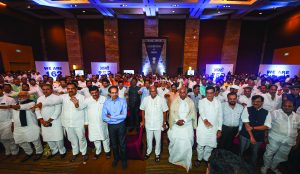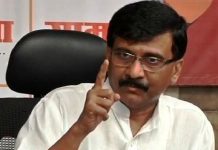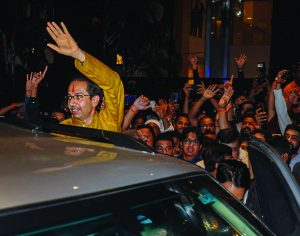 After many twists and turns in the Maharashtra politics, Shiv Sena chief Uddhav Thackeray’s finally became the new chief minister of the State with the support of Congress and NCP. The Congress, which reportedly gave up its claim on the Speaker’s post, got 13 berths — nine cabinet and four state. The power partners have also jointly agreed to allot 16 berths for the Sena and 15 for the NCP.
After many twists and turns in the Maharashtra politics, Shiv Sena chief Uddhav Thackeray’s finally became the new chief minister of the State with the support of Congress and NCP. The Congress, which reportedly gave up its claim on the Speaker’s post, got 13 berths — nine cabinet and four state. The power partners have also jointly agreed to allot 16 berths for the Sena and 15 for the NCP.
The possible names doing the rounds for the cabinet berths are Vijay Namdevrao Wadettiwar, Yashomati Thakur, Nana Patole, Varsha Gaikwad, Amin Patel, Ashok Chavan, Amit Deshmukh, Bunty Patil, Vishwajit Kadam, KC Padvi and four state ministers.
November 27 witnessed hectic developments in the state as the 288 new MLAs were sworn-in and cameras had a field day as NCP’s Supriya Sule warmly welcomed her cousin Ajit Pawar to the ceremony with a hug. Dismissing reports of rift between the two after Pawar rebelled against the party and joined hands with the BJP, though he called off the alliance within three days and the government lasted just as long.
Earlier, Devendra Fadnavis had resigned as Maharashtra chief minister on November 26 ahead of the floor test shortly after rebel NCP leader Ajit Pawar did a u-turn and quit as the BJP leader’s deputy, in another dramatic twist to the month-long political drama that saw Shiv Sena supremo Uddhav Thackeray head the new government.
Uddhav, who had emerged as a consensus candidate on the eve of November 22 and was set to be the chief minister before the BJP turned the tables on its former ally, has become the first from the Thackeray family to assume a government post. His father late Bal Thackeray wielded the ‘remote control’ over the first Sena-BJP combine government during 1995-99 but never assumed a position in the government. Uddhav Thackeray recently recalled the “promise” he had made to his late father to install a ‘Shiv Sainik’ (party worker) as chief minister of Maharashtra.
Reacting to the latest development, Fadnavis said, “I doubt that this three-wheeler govt will be stable but BJP will work as an effective opposition and try to raise the voice of people.”
On November 26, the Supreme Court had ordered a floor test for Fadnavis government and asked Maharashtra Governor Bhagat Singh Koshyari to appoint a pro-tem speaker and ensure all elected members of the House are sworn in on Wednesday.
At the time, the floor test was supposed to determine the strength of rival groups in the state assembly. On the morning of November 23, Devendra Fadnavis had sworn in as chief minister along with Ajit Pawar of the Nationalist Congress (NCP) as Deputy CM.
Interestingly, the dramatic return of Fadnavis came hours after the Shiv Sena, Congress and NCP announced that a new government headed by Uddhav would be formed in Maharashtra. Aggrieved by the actions of the state governor, Shiv Sena and other coalition partners — Congress and the NCP — had approached the Supreme Court the same day against the arbitrary and mala-fide actions and decisions ‘of the state governor.
On November 24, the Apex Court directed the Centre as well as the sworn-in chief minister Fadannvis to produce letter showing the governor invited him to form the government along with Fadnavis’ letter staking claim to form government. On November 25, a 3-Judge Bench comprising justices NV Ramana, Ashok Bhushan and Sanjiv Khanna, heard the pleas of Cong-NCP-Shiv Sena combine represented by Kapil Sibal and AM Singhvi, the Centre represented by its Solicitor General Tushar Mehta and senior advocate Mukul Rohatgi, wasrepresenting the BJP and some independent MLAs in the matter.
The Solicitor General Tushar Mehta, representing the Central Government, while submitting letters of the Maharashtra Governor Bhagat Singh Koshyari and current Chief Minister Devendra Fadnavis in the Supreme Court, pleaded that the Governor was cognizant of facts and the situation after polls results that had led to invoking of President’s rule in the State. He further added that the Governor recommended President’s rule in the State after being assured that no party was in position to form government in Maharashtra.
The Supreme Court was looking into the letters of the Maharashtra Chief Minister Devendra Fadnavis and the Deputy Chief Minister Ajit Pawar with regards to staking claim for forming the Maharashtra government. The Solicitor General said the letters had endorsement of all 54 NCP MLAs. It also scanned the letter by the Maharashtra Governor Koshyari. Koshyari’s letter had invited Devendra Fadnavis to form the government in the State.
Senior advocate Mukul Rohatgi, representing the BJP and some independent MLAs in the matter, while stating that Ajit Pawar’s letter supported Devendra Fadnavis, further added that it was nobody’s case that the letters had been forged and the Maharashtra Governor had acted correctly. In reply to Mukul Rohatgi’s plea that it was end of “their case,”, the Supreme Court quipped: “Whether the Chief Minister enjoys a majority support on the floor of the House has to be decided,”
Kapil Sibal, representing the Shiv Sena in the Apex Court, whilereferring to the presser of three parties, where Uddhav Thackeray was declared the Maharashtra Chief Minister, in his plea said: “Where was the national emergency to revoke the President’s rule at 5:27 AM and the Chief Minister being administered oath at 8 AM next morning?” While referring to the alleged haste by which President’s rule was revoked and new government was formed in Maharashtra, Sibal said that it hadnever been done in the history of the country and Congress-NCP-Shiv Sena combine has affidavits of 154 Maharashtra MLAs supporting it, if the BJP had numbers, then they could asked to prove their majority within 24 hours.
Senior advocate AM Singhvi, representing Sharad Pawar’s NCP and Congress in the Supreme Court, while submitting the affidavits of .154 Maharashtra MLAs supporting the combine three parties, called the hasty action of swearing in of Fadnavis as CM as fraud of worst kind and called for an immediate floor test. Nevertheless, the Apex Court asked Singhvi to withdraw the fresh plea with affidavits of 154 Maharashtra MLAs supporting the combine as it had not been supplied to the BJP. With the Apex Court having delineated the test on the floor of the state assembly, the ball now lies in the court of Maharashtra state assembly that will sift chaff off the grain.
Preceding drama
The return of Devendra Fadnavis on the morning of November 23 as Maharashtra’s Chief Minister in a dramatic manner with the reported support of Ajit Pawar of the NCP, who was alsosworn as Deputy CM by the state Governor concurrently, more twists and turns in Maharashtra politics had started occurring.According to media reports, Ajit Pawar had silently left the meeting late Friday night of November 22 and reportedly hadgone to his interlocutors in the BJP and provided them a letter carrying the signatures of 54 NCP legislators.
Undoubtedly, sources in the state unit of the BJP reportedly claimed at that juncture that the letter with the signatures pledging support to a Fadnavis-led government came from the NCP Legislature Party leader and hence there was no requirement of seeking separate letters of support from individual MLAs of the NCP; nonetheless, many experts doubted the longevity of the Fadnavis government, especially when some NCP MLAs, who accompanied Ajit Pawar to Raj Bhavan on the morning of November 23, had subsequentlyaccusing the NCP leader of misguiding them and three of these MLAs showed up at Sharad Pawar’s press conference on the same day.
The BJP staged the coup at the eleventh hour when Shiv Sena, NCP and Congress had forged an alliance to form the next government in Maharashtra with consensus on the name of Uddhav Thackeray, Shiv Sena supremo, as the chief minister, had seemingly been reached.
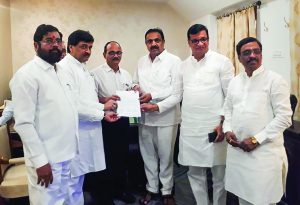 Past few days have been characterized by flurry of hectic political activities in the camps of all the three alliance partners, with the BJP being bogged down with ‘wait and watch’scenario. After having reached amicable solution to allocation of portfolios in the future coalition government and consensual decision on the next Speaker for the newly-elected State Assembly in coming days, way would have been perhaps paved for the installation of the coalition government headed by Uddhav Thackeray culminating in the lifting of President’s Rule in the state along with ending over the month-long political logjam in the state that had been in vogue after the results of assembly elections were declared.
Past few days have been characterized by flurry of hectic political activities in the camps of all the three alliance partners, with the BJP being bogged down with ‘wait and watch’scenario. After having reached amicable solution to allocation of portfolios in the future coalition government and consensual decision on the next Speaker for the newly-elected State Assembly in coming days, way would have been perhaps paved for the installation of the coalition government headed by Uddhav Thackeray culminating in the lifting of President’s Rule in the state along with ending over the month-long political logjam in the state that had been in vogue after the results of assembly elections were declared.
Coming together of ideologically poles apart parties like Shive Sena, which had been an ally of the BJP for about three decades, with NCP and Congress, which have been long-time allies, is a curious development for many political pundits. Growing disenchantment between Shiv Sena and the BJP, which had jointly contested state Assembly polls and together won comfortable majority to form the next government, over the issue of equal sharing of the chief ministerial tenure, spurred Shiv Sena to look for other options that finally culminated in the formation of alliance between Shiv Sena, NCP and Congress.
BJP-Shiv Sena split
Interestingly, Shiv Sena and BJP had contested the state Assembly polls in Maharashtra held in October 2019 as alliance partners and jointly cobbled up 161 seats in 288-seat assembly, a sufficient number to form the next government. Nevertheless, Shiv Sena’s insistence on equal-sharing of the chief ministerial tenure and BJP’s reluctance to accede to Sena’s this demand resulted on acrimony and impasse in government formation, despite protracted negotiations. With the BJP having won 105 seats and its emergence as a single largest party, it was not in a position to form the government of its own and support of Shiv Sena that had won 56 seats was essential for the BJP in government formation.
Sensing its ‘numerical indispensability’ in the formation of next government, Sena took the bold decision of exacting chief ministerial post from the BJP, contending that a 50-50 formula for power sharing, mutually agreed between the partners, must hold under the prevalent circumstances. However, insistence of the BJP that its incumbent would be the chief minister for full tenure or nobody led to parting of ways between Sena and the BJP, thereby, putting a full-stop to three-decade old partnership between Sena and the BJP that had commenced in 1990. Politics in Maharashtra from 1990 onwards witnessed Sena-BJP combination fighting assembly and Lok Sabha elections together to emerge as a strong Opposition to the then ruling Congress on the plank of political Hindutva. For about two-and-a- half decades, Sena-BJP combo, though not presenting a semblance of a happy alliance, often fended off periodic crises; and continued their political partnership by agreeing to let Sena the lion’s share in state assembly while allowing the BJP to have major chunk in the Lok Sabha polls.
A point of departure in relationship between Sena-BJP combo emerged in 2014 when the BJP under the leadership of Narendra Modi and Amit Shah, having registered resounding victory in the May 2014 Lok Sabha polls, decided that the party should contest Maharashtra assembly polls of its own. However, inability of the BJP to cobble up enough numbers to form a government of its own made the party to turn to Sena for support. On the eve of Lok Sabha elections in May 2019, BJP aligned with Sena. During the 2014-2019 period, the BJP had grown exponentially within Maharashtra while Sena witnessed a split with the departure of Raj Thackeray who floated the Maharashtra Navnirman Sena (, which could not make much impact, and Sena under Uddhav Thackeray remained confined to its traditional strongholds.
In the wake of underwhelming performance of the BJP in the recently held assembly elections and its inability to form the government of its own despite its emergence as a single largest party, perhaps emboldened Sena Supremo to dictate its terms for supporting the BJP and the latter’s reluctance to succumb to former’s pressure tactics left wide options for Sena to seek alliances with NCP and Congress. Nevertheless, recentdevelopments have widened the chasm between the two and it may not be engulfed soon.
Congress+NCP+Shiv Sena Alliance
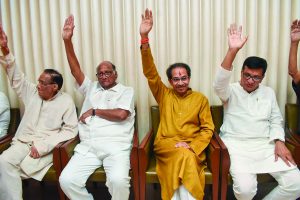 After prolonged negotiations spanning over a week, Congress and NCP combine had been able to hammer out an alliance with Shiv Sena to form the coalition government with Sena Supremo being the next chief minister for full tenure and details about common minimum programme (CMP), allocation of portfolios along with allocation of berths in the Council of Ministers for each coalition partner as well as choice of Speaker etc., were reportedly to be worked out. With major hurdle of designating the chief minister having been overcome with consensus showedthat alliance partners were serious in providing a stable government that could last full term.
After prolonged negotiations spanning over a week, Congress and NCP combine had been able to hammer out an alliance with Shiv Sena to form the coalition government with Sena Supremo being the next chief minister for full tenure and details about common minimum programme (CMP), allocation of portfolios along with allocation of berths in the Council of Ministers for each coalition partner as well as choice of Speaker etc., were reportedly to be worked out. With major hurdle of designating the chief minister having been overcome with consensus showedthat alliance partners were serious in providing a stable government that could last full term.
Many experts agree that the crux of the agreement among the alliance partners rested on the power-sharing formula. According to media reports, the alliance partners were trying hard to arrive at a consensus on 16-15-12 cabinet berth formula, which included the chief minister’s chair for the Sena and that had already been decided. These reports also made it discernible that the formula primarily meant 16 berths for the Sena; 15 ministers from the NCP and 12 from the Congress.
The NCP andthe Congress were likely to have the deputy CM post each. The post of the Speaker was likely to go to the NCP. Smaller political parties like Raju Shetti-led Swabhimani Paksh,Hitendra Thakur-led Bahujan Vikas Aghadi, Samajwadi Party,CPI-M (1) and Peasants and Workers Party (PWP) — that had allied with the Congress-NCP — had also expressed their willingness to join the coalition.
Media reports then indicated that Shiv Sena led alliance comprising NCP and Congress would perhaps be named as ‘Maha Vikas Aghadi’. Almost all the coalition partners were sanguine about the success of the alliance and its ability to deliver and complete the full tenure. The tone and tenor of over a week-long hard negotiations and ability to overcome hiccups demonstrated that alliance partners were serious about the challenges ahead and what they required was strong will power to overcome these challenges.
Way Ahead
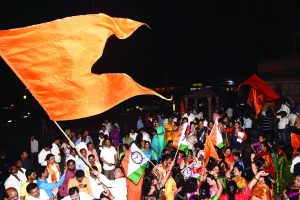 Power-sharing unites the ideologically poles apart political parties and it is on the question of sharing power that such parties fall apart and the Janata Party phase (1977-1979) is the stark example of this. The politics in Maharashtra has witnessed many twists and turns and the future of Fadnavis government is to be decided by the floor test in the assembly.
Power-sharing unites the ideologically poles apart political parties and it is on the question of sharing power that such parties fall apart and the Janata Party phase (1977-1979) is the stark example of this. The politics in Maharashtra has witnessed many twists and turns and the future of Fadnavis government is to be decided by the floor test in the assembly.
What the state needs at this juncture is a stable government that can ensure restoration of dynamism. Nevertheless, going by the sequence of events that have preceded in recent weeks, it appears that rule of law is gradually paving way for rule of power. Developments in Maharashtra will have repercussions on the poll-bounds states in the near future.
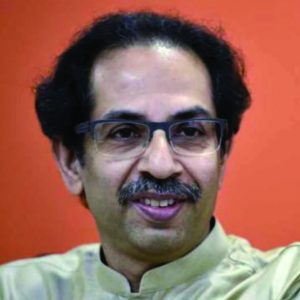 “I had never dreamed of leading the state. I would like to thank Congress interim president Sonia Gandhi and other leaders.”
“I had never dreamed of leading the state. I would like to thank Congress interim president Sonia Gandhi and other leaders.”
Uddhav Thackeray, Chief Minister
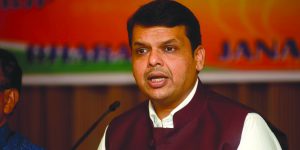 “I doubt that this three-wheeler govt will be stable but BJP will work as an effective opposition and try to raise the voice of people.”
“I doubt that this three-wheeler govt will be stable but BJP will work as an effective opposition and try to raise the voice of people.”
Devendra Fadnavis, BJP leader
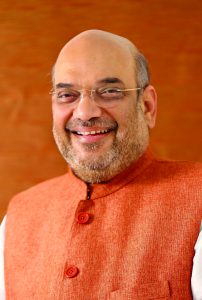 “Is it not horse-trading to take support by offering chief minister’s position. I am again telling Sonia Gandhi and Sharad Pawar to claim chief minister’s post and then take Shiv Sena’s support.”
“Is it not horse-trading to take support by offering chief minister’s position. I am again telling Sonia Gandhi and Sharad Pawar to claim chief minister’s post and then take Shiv Sena’s support.”
Amit Shah, Union Home Minister
letters@tehelka.com

